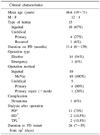Abstract
Purpose
The incidence of hernia is estimated to be 3~5% in the general population. In patients on continuous ambulatory peritoneal dialysis (CAPD), the incidence of hernia is 6~25% and immediate surgical treatment is critical to maintain CAPD. This study was performed to identify clinical characteristics of hernias in CAPD patients and evaluate the surgical results.
Methods
We retrospectively analyzed 13 prospectively registered patients (male:female=12:1) on CAPD treated with hernia between March 1998 and June 2008 at the Seoul National University Hospital by one surgeon. Perioperatively, patients underwent intermittent hemodialysis via internal jugular catheter indwelled just before the operation. Peritoneal dialysis was resumed between 2 weeks and 2 months after operation.
Results
Mean age was 46.6 years (range: 19~71 years). Fifteen hernias developed in 13 patients, of which, 10 (67%) were inguinal and 5 (33%), umbilical. Mean duration from CAPD start to onset of hernia was 31.4 months (range: 0~129 months). All inguinal hernia patients received standard McVay operation, 3 patients with umbilical hernia were repaired with primary herniorrhaphy and 1 patient with large fascial defect needed mesh implant. During mean follow-up periods of 31 months, recurrence was detected in 1 patient in umbilical hernia group. The only complication related to operation was wound hematoma in one patient. Two patients were converted to hemodialysis after operation because of low compliance to peritoneal dialysis in one patient and suspected catheter-related infection in the other.
Figures and Tables
References
1. Malangoni MA, Gagliardi RJ. Townsend CM, Beauchamp RD, Evers BM, Mattox KL, editors. Hernias. Sabiston Textbook of Surgery: The Biological Basis of Modern Surgical Practice. 2004. 17th ed. Philadelphia: W.B. Saunders;1199–1218.
2. Haider MH, Ather M, Iqbal M, Khaliq T. Strangulated inguinal hernia: an unusual presentation. J Pak Med Assoc. 2003. 53:36–38.
3. Lichtenstein IL. Hernia Repair without Disability. 1986. 2nd ed. St. Louis: Ishiyaku EuroAmerica.
4. Basaran O, Moray G, Yagmurdur MC, Aydogan C, Karakayali H. Six years of surgical experience with continuous ambulatory peritoneal dialysis at one center. Transplant Proc. 2002. 34:2039–2040.
5. Apostolidis NS, Tzardis PJ, Manouras AJ, Kostenidou MD, Katirtzoglou AN. The incidence of postoperative hernia as related to the site of insertion of permanent peritoneal catheter. Am Surg. 1988. 54:318–319.
6. Rubin J, Raju S, Teal N, Hellems E, Bower JD. Abdominal hernia in patients undergoing continuous ambulatory peritoneal dialysis. Arch Intern Med. 1982. 142:1453–1455.
7. Tsang LY, Hung CY, Peng SJ, Ferng SH, Yang CS. Hernia in ESRD patients receiving peritoneal dialysis. Acta Nephrol. 2002. 16:57–61.
8. von Lilien T, Salusky IB, Yap HK, Fonkalsrud EW, Fine RN. Hernias: a frequent complication in children treated with continuous peritoneal dialysis. Am J Kidney Dis. 1987. 10:356–360.
9. Suh H, Wadhwa NK, Cabralda T, Sokunbi D, Pinard B. Abdominal wall hernias in ESRD patients receiving peritoneal dialysis. Adv Perit Dial. 1994. 10:85–88.
10. Rocco MV, Stone WJ. Abdominal hernias in chronic peritoneal dialysis patients: a review. Perit Dial Int. 1985. 5:171–174.
11. Lee JH, Yoon HS, Cho HS, Lee EJ, Yoo YB, Park JH, et al. Inguinal hernia presenting as scrotal edema in patients on continuous ambulatory peritoneal dialysis. Korean J Nephrol. 2008. 27:487–491.
12. Garcia-Urena MA, Rodriguez CR, Vega Ruiz V, Carnero Hernandez FJ, Fernandez-Ruiz E, Vazquez Gallego JM, et al. Prevalence and management of hernias in peritoneal dialysis patients. Perit Dial Int. 2006. 26:198–202.
13. Del Peso G, Bajo MA, Costero O, Hevia C, Gil F, Diaz C, et al. Risk factors for abdominal wall complications in peritoneal dialysis patients. Perit Dial Int. 2003. 23:249–254.
14. Afthentopoulos IE, Panduranga Rao S, Mathews R, Oreopoulos DG. Hernia development in CAPD patients and the effect of 2.5 l dialysate volume in selected patients. Clin Nephrol. 1998. 49:251–257.
15. Durand PY, Chanliau J, Gamberoni J, Hestin D, Kessler M. Routine measurement of hydrostatic intraperitoneal pressure. Adv Perit Dial. 1992. 8:108–112.
16. Bargman JM. Complications of peritoneal dialysis related to increased intraabdominal pressure. Kidney Int Suppl. 1993. 40:S75–S80.
17. Morris-Stiff G, Coles G, Moore R, Jurewicz A, Lord R. Abdominal wall hernia in autosomal dominant polycystic kidney disease. Br J Surg. 1997. 84:615–617.
18. Modi KB, Grant AC, Garret A, Rodger RS. Indirect inguinal hernia in CAPD patients with polycystic kidney disease. Adv Perit Dial. 1989. 5:84–86.
19. Winchester JF, Kriger FL. Fluid leaks: prevention and treatment. Perit Dial Int. 1994. 14:Suppl 3. S43–S48.
20. Mettang T, Stoeltzing H, Alscher DM, Magadum S, Dunst R, Kuhlmann U. Sustaining continuous ambulatory peritoneal dialysis after herniotomy. Adv Perit Dial. 2001. 17:84–87.
21. Shah H, Chu M, Bargman JM. Perioperative management of peritoneal dialysis patients undergoing hernia surgery without the use of interim hemodialysis. Perit Dial Int. 2006. 26:684–687.
22. Morris-Stiff GJ, Bowrey DJ, Jurewicz WA, Lord RH. Management of inguinal herniae in patients on continuous ambulatory peritoneal dialysis: an audit of current UK practice. Postgrad Med J. 1998. 74:669–670.
23. Rutkow IM, Robbins AW. "Tension-free" inguinal herniorrhaphy: a preliminary report on the "mesh plug" technique. Surgery. 1993. 114:3–8.
24. Jaenigen BM, Hopt UT, Obermaier R. Inguinal hernia: mesh or no mesh in open repair? Zentralbl Chir. 2008. 133:440–445.
25. Lau H, Patil NG. Umbilical hernia in adults. Surg Endosc. 2003. 17:2016–2020.
26. Mislowsky A, Hemphill A, Nasrallah DV. A scarless technique of umbilical hernia repair in the adult population. Hernia. 2008. 12:627–630.
27. Gianetta E, Civalleri D, Serventi A, Floris F, Mariani F, Aloisi F, et al. Anterior tension-free repair under local anesthesia of abdominal wall hernias in continuous ambulatory peritoneal dialysis patients. Hernia. 2004. 8:354–357.
28. Aranda RA, Romao JE Junior, Kakehashi E, Domingos W, Sabbaga E, Marcondes M, et al. Intraperitoneal pressure and hernias in children on peritoneal dialysis. Pediatr Nephrol. 2000. 14:22–24.




 PDF
PDF ePub
ePub Citation
Citation Print
Print




 XML Download
XML Download